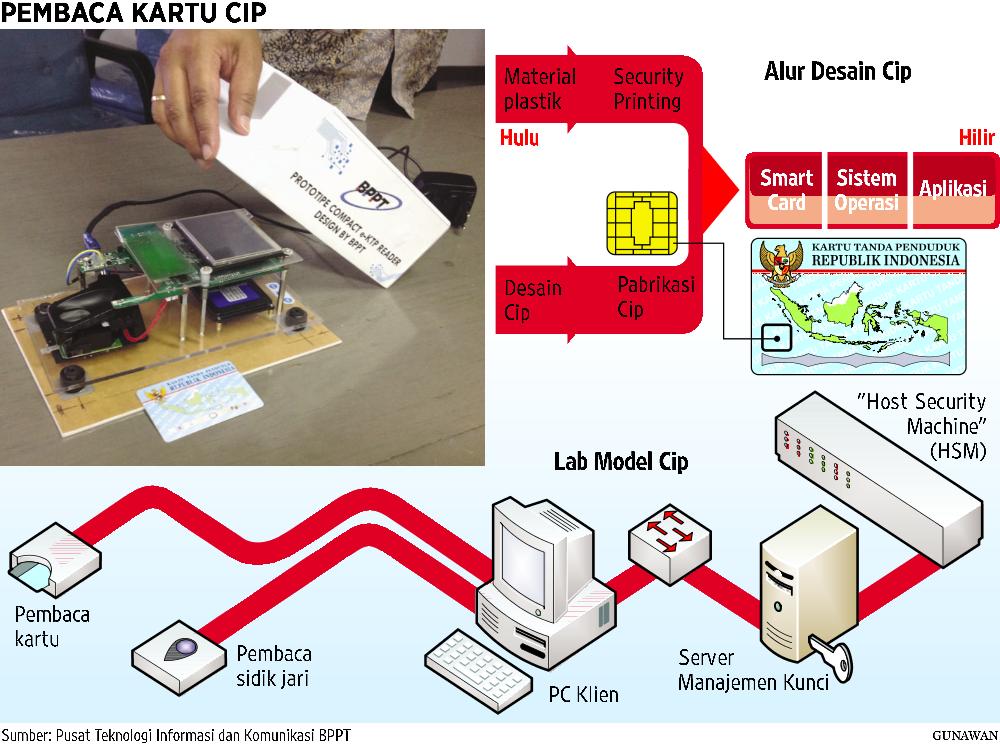
The progress and development of chip card technology and its use in particular has been started since 2009. Use covers design chip cards, a tool to read the card to the security of information systems and the data store. Karu contactless reading system used in the second generation of national e-ID program.
In a program that encouraged the national identity cards known as electronic or e-ID card in lieu of the old identity card already contains the data to store data Cip card owners. Design and engineering of the card held by the Center for Information and Communication Technology Agency for the Assessment and Application of Technology (BPPT) in collaboration with the interior ministry carried out since 2009.
Design is done in the program includes several stages of development, ranging from chip design, system design writer and card reader, then the design chip with the processor module and the crypto coprocessors. After the design phase, carried out the design (prototyping) which includes the chip, chip operating system, device reader / writer card, to laboratory models of chip. According Kingpin S Wibowanto, Chief Programme Engineer Research and e-ID at the Center for Information and Communication Technology (ICT) BPPT said "Today the development of e-ID system has reached phase III,". He also explained in the first stage have developed the ability to read e-ID card safely, but do not enter data in the fingerprint card. In the second stage of integration with fingerprint data and the implementation of data validation techniques in chip card reader device. However, the validation rate is still relatively long, about 1 minute. Currently e-KTP team BPPT has reached phase III development of the second generation of readers. The aim is to speed up the reading of the data. In trials, the reading of the card by the card reader prototype only takes less than 15 seconds.
Electronic identity cards (e-KTP) is at first glance no different from the previous ID card in terms of size.However, blank smart card that contains a chip composed of 7 layers made from polyethylene terephthalate glycol (PET-G) measuring 85.60 x 53.98 mm, with a thickness of 0.76 to 1 mm. To prevent a variety of crimes against the e-ID card, required additional security features for initialization, identification, and verification of identity. The security features of the design must consider several factors, such as durability (resistance) to pressure, heat and cold, as well as to certain chemicals, ranging from detergent, salt water, to fuel oil.
These cards are resistant to bending up to 3,000 times. High temperature resistant up to 75 degrees Celsius for 24 hours. "Therefore, when the heating has no effect on the copy of the e-ID card," said Meidy Layooari, e-KTP researcher at the Center for ICT BPPT. Product Design e-KTP has escaped from testing conducted Sentra Puspiptek Polymer Technology BPPT in Serpong, Meidy explained.
Chip card is also called "smart card" because it has a microprocessor as the "brain" capable of storing data up to 8 kilobytes. Data stored cardholder includes biographical data, signature, picture, and two fingerprint data, the right-and left-hand index. The data entry is done during the data collection at the village or district with a series of data recorders, which camera to take pictures of faces, iris scanners, signature recorder, fingerprint recorder, and a data input device on the card. All data is stored in the server computer in the district.
The electronic identity card belonging contactless chip cards because they do not need to attach the reader when the identification data in the chip. This is possible because the card is equipped with a micro-sized antenna cable in dalamnya.Data the chip is transmitted via radio waves from an antenna installed in it. With the reader device about the size of a tissue box, the data from the chip card can be read at a distance of up to 10 sentimeter.Dalam chip card security systems also exist in the form of data authentication between chip and tool assessor (reader / writer), as well as to maintain the confidentiality of data encryption and signatures. E-ID chip interface which has now been developed that meets the international standards ISO 14443 ISO 14443 A or B. Device card reader (card reader) also refers to these standards. The data encryption system developed in collaboration with the Institute of the State Code.
The identification process is done by comparing the identity of the single biometric data recording the population in the district / sub-district, a 10 and 2 record fingerprints and iris images of faces, the biometric data of the population has been stored in the database in the Data Center e-KTP Ministry of Home Affairs, making efforts to make ID cards double by changing the name, date of birth, and so on will not work because the comparison is the biometric data of the population.
A second verification process to ensure the e-ID card is held by the owner carried through KTP reader. The trick, card holders are asked to put a finger on the scanner, to determine the similarity of the fingerprint data is recorded in the chip. In contrast to the first process, the verification process relies only feature fingerprint information.
Sources:
Compass Print
www.htysite.com
Metatags
o chip chip, chip cards, electronic ID card, phone 4, i touch 4, i phone4, Kred it, promo cards, bank cards,






Posting Komentar